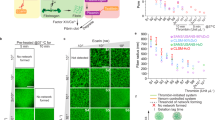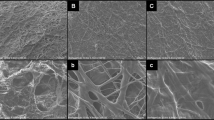Abstract
Fibrin plays an important role in wound healing and regeneration, and enjoys widespread use in surgery and tissue engineering. The enzymatic activity of Factor XIIIa was employed to covalently incorporate exogenous bioactive peptides within fibrin during coagulation. Fibrin gels were formed with incorporated peptides from laminin and N-cadherin alone and in combination at concentrations up to 8.2 mol peptide per mole of fibrinogen. Neurite extension in vitro was enhanced when gels were augmented with exogenous peptide, with the maximal improvement reaching 75%. When this particular fibrin derivative was evaluated in rats in the repair of the severed dorsal root within polymeric tubes, the number of regenerated axons was enhanced by 85% relative to animals treated with tubes filled with unmodified fibrin. These results demonstrate that it is possible to enhance the biological activity of fibrin by enzymatically incorporating exogenous oligopeptide domains of morphoregulatory proteins.
This is a preview of subscription content, access via your institution
Access options
Subscribe to this journal
Receive 12 print issues and online access
$209.00 per year
only $17.42 per issue
Buy this article
- Purchase on Springer Link
- Instant access to full article PDF
Prices may be subject to local taxes which are calculated during checkout



Similar content being viewed by others
References
Langer, R. & Vacanti, J. Tissue engineering. Science 260, 920–926 (1993).
Peppas, N. & Langer, R. New challenges in biomaterials. Science 263, 1715–1720 (1994).
Hubbell, J. Biomaterials in tissue engineering. Biotechnology 13, 565–576 (1995).
Pittman, R.N. & Buettner, H.M. Degradation of extracellular matrix by neuronal proteases. Dev. Neurosci. 11, 361–375 (1989).
Herbert, C.B., Bittner, G.D. & Hubbell, J.A. Effects of Fibrinolysis on neurite growth from dorsal root ganglia cultured in two- and three-dimensional fibrin gels. J. Comp. Neurol. 365, 380–391 (1996).
Lander, A. Understanding the molecules of cell contacts. Trends Neurosci. 12, 189–195 (1989).
Malinda, K.M. & Kleinman, J.K. The laminins. Int. J. Biochem. Cell Biol. 28, 957–959 (1996).
Luckenbill-Edds, L. Laminin and the mechanism of neuronal outgrowth. Brain Res. Brain Res. Rev. 23, 1–27 (1997).
Martin, G.R. Laminin and other basement membrane proteins. Ann. Rev. Cell Biol. 3, 57–85 (1987).
Tashiro, K. et al. The RGD containing site of the mouse laminin A chain is active for cell attachment, migration and neurite outgrowth. J. Cell Physiol. 146, 451–459 (1991).
Tashiro, K., Sephel, G.E. & Weeks, B. A synthetic peptide containing the IKVAV sequence from the α chain of laminin mediates cell attachment, migration and neurite outgrowth. J. Biol. Chem. 264, 16174–16182 (1989).
Graf, J. et al. Identification of an amino acid sequence in laminin mediating cell attachment, chemotaxis, and receptor binding. Cell 48, 989–996 (1987).
Kleinman, H.K. et al. Identification of a second site in laminin for promotion of cell adhesion and migration and inhibition of in vivo melanoma lung colonization. Arch. Biochem. Biophys. 272, 39–45 (1989).
Massia, S.P., Rao, S.S. & Hubbell, J.A. Covalently immobilized laminin peptide Tyr-Ile-Gly-Ser-Arg (YIGSR) supports cell spreading and colocalization of the 67 kilodalton receptor with α-actinin and viniculin. J. Biol. Chem. 268, 8053–8059 (1993).
Liesi, P., Narvanen, A., Soos, J., Sariola, H. & Snounou, G. Identification of a neurite-outgrowth promoting domain using synthetic peptides. FEBS Lett. 244, 141–148 (1989).
Hynes, R.O. Integrins: versatility, modulation, and signaling in cell adhesion. Cell 69, 11–25 (1992).
Yamada, K.M. Adhesive recognition sequences. J. Biol. Chem. 266, 12809–12812 (1991).
Zutter, M.M. & Santaro, S.A. Widespread histologic distribution of the α2β1 integrin cell-surface receptor. Am. J. Pathol. 137, 113–120 (1990).
Letourneau, P.C., Shattuck, T.A., Roche, F.K., Takeichi, M. & Lemmon, V. Nerve growth cone migration onto Schwann cells involves the calcium-dependent adhesion molecule, N-cadherin. Dev. Biol. 138, 430–442 (1990).
Blaschuk, O.W. Identification of cadherin cell adhesion recognition sequence. Dev. Biol. 139, 227–229 (1990).
Schense, J.C. & Hubbell, J.A. Cross-linking exogenous bifunctional peptides into fibrin gels with Factor XIIIa. Bioconjug. Chem. 10, 75–81 (1999).
Sakata, Y. & Aoki, N. Cross-linking of α2-plasmin inhibitor to fibrin by fibrin-stabilizing factor. J. Clin. Invest. 65, 290–297 (1980).
Ichinose, A., Tamaki, T. & Aoki, N. Factor XIII-mediated cross-linking of NH2−terminal peptide of α2-plasmin inhibitor to fibrin. FEBS Lett. 153, 369–371 (1983).
Schense, J.C. & Hubbell, J.A. Three-dimensional migration of neurites is mediated by adhesion site density and affinity. J. Biol. Chem. in press (2000).
Sakiyama, S.E., Schense, J.C. & Hubbell, J.A. Incorporation of heparin-binding peptides into fibrin gels enhances neurite extension: an example of designer matrices in tissue engineering. FASEB J. 13, 2214–2224 (1999).
Sakiyama-Elbert, S.E. & Hubbell, J.A. Development of fibrin derivatives for controlled release of heparin-binding growth factors. J. Control Release 65, 389–402 (2000).
Palecek, S.P., Loftus, J.C., Ginsberg, M.H., Lauffenburger, D.A. & Horwitz, A.F. Integrin-ligand binding properties govern cell migration speed through cell–substratum adhesiveness. Nature 385, 537–540 (1997).
McCormack, M.L., Goddard, M., Guenard, V. & Aebischer, P. Comparison of dorsal and ventral spinal root regeneration through semipermeable guidance channels. J. Comp. Neurol. 313, 449–456 (1991).
Williams, L.R. & Varon, S. Modification of fibrin matrix formation in situ enhances nerve regeneration in silicone chambers. J. Comp. Neurobiol. 231, 209–220 (1985).
Fields, G. & Noble, R. Solid phase peptide synthesis utilizing 9-fluorenylmethoxycarbonyl amino acids. Intl. J. Pept. Protein Res. 35, 161–214 (1990).
Varon, S.J., Nomura, J., Perez-Polo, J.R. & Shooter, E.M. The isolation and assay of the nerve growth factor proteins. In Methods of Neurochemistry (Marcel Dekker Inc., ed. Fried, R.) 203–229, New York, 1972).
Acknowledgements
This work was funded by Grant 31-52261 NFP 38 of the Swiss National Science Foundation.
Author information
Authors and Affiliations
Corresponding author
Rights and permissions
About this article
Cite this article
Schense, J., Bloch, J., Aebischer, P. et al. Enzymatic incorporation of bioactive peptides into fibrin matrices enhances neurite extension. Nat Biotechnol 18, 415–419 (2000). https://doi.org/10.1038/74473
Received:
Accepted:
Issue Date:
DOI: https://doi.org/10.1038/74473
This article is cited by
-
Electrical stimulation via repeated biphasic conducting materials for peripheral nerve regeneration
Journal of Materials Science: Materials in Medicine (2023)
-
Extracellular Matrix by Design: Native Biomaterial Fabrication and Functionalization to Boost Tissue Regeneration
Regenerative Engineering and Translational Medicine (2022)
-
Polyurethane/Gelatin Nanofiber Neural Guidance Conduit in Combination with Resveratrol and Schwann Cells for Sciatic Nerve Regeneration in the Rat Model
Fibers and Polymers (2019)
-
Design, clinical translation and immunological response of biomaterials in regenerative medicine
Nature Reviews Materials (2016)



